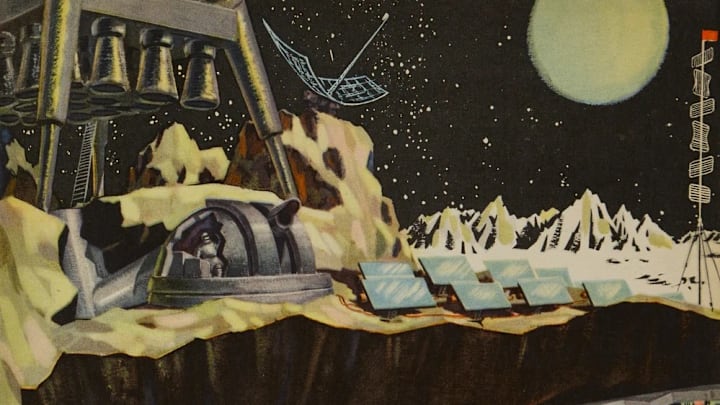From liaising with Martians to living on the moon, here’s where Soviet magazines thought the Cold War’s space race would take us.
During the Russian Revolution, Soviet leaders began to lean on popular science periodicals to educate the masses, publicize the nation’s accomplishments, and foster enthusiasm for a future in which the Soviet Union hoped to be a worldwide pioneer in science, technology, and just about everything else. There were science magazines for men, women, and even children, and their content ranged from step-by-step instructions for building a radio receiver to science fiction stories by the Strugatsky brothers, Arkady and Boris, and other authors.
The trend continued long after the 1920s. In October 1957, the nation kicked off the Space Age by successfully launching the first artificial satellite, Sputnik 1—the first of several exciting events in space exploration that popular science publications would cover at length, along with much speculation about what might come next. In Soviet Space Graphics: Cosmic Visions From the USSR, Moscow Design Museum founder Alexandra Sankova compiled more than 250 illustrations from Soviet media that capture the wonder and optimism of a time when it seemed like humans were on the cusp of liaising with Martians and living on the moon. From aircrafts shaped like dragonflies to satellite gadgets shaped like cartoon characters, here are 10 of our favorite images from the book. It’s available from Phaidon, and you can order it here.
1. Technology for the Youth, Issue 2 // 1959

This illustration by B. Dashkov accompanied the article "What Would a Space Station on the Moon Look Like?"
2. Technology for the Youth, Issue 8 // 1958

N. Kolchitsky's "Machines—Astronauts" re-imagines the individual components of Sputnik 3 as cartoonish characters.
3. Young Technician, Issue 8 // 1979

R. Avotin celebrates the graduating class of a young bionics enthusiasts club with this illustration, whose caption translates to "Nature gave wings not only to birds. May bug, dragonfly, butterfly ... how do they fly? Maybe by unraveling this mystery, designers will be able to create the perfect aircraft."
4. Sailors of the Universe by Boris Anibel

Humans come face to face with mysterious Martians in L. Epple's illustration for Boris Anibel's science fiction novel Sailors of the Universe.
5. Technology for the Youth, Issue 4 // 1956

A. Pobedinsky's illustration for the article "Brain Emits Stars on the Oscilloscope Screen" contemplates the human brain's possible emission of electromagnetic waves and potential for telepathy.
6. Knowledge is Power, Issue 10 // 1960

This is V. Viktorov's sketch of Belka ("Whitey") and Strelka ("Little Arrow"), the first living creatures—along with 42 mice, two rats, a rabbit, and some flies—to survive space, on Sputnik 5 in August 1960.
7. Knowledge Is Power, Issue 2 // 1954

K. Artseulov illustrated the article "Five Days in a Hot Air Balloon," which speculates about the possibility of using hot air balloons for long-distance flights.
8. Young Technician, Issue 7, 1968

An illustration by R. Avotin depicts children whimsically orbiting a planet as though they're on an amusement park ride.
9. Outlook, Issue 4 // 1976

This illustration by S. Alimov is called "Yuri Gagarin: Let's Go!" This issue of the magazine came with a flexi-disc record, whose first track was a recording called "Planet Earth Is Beautiful" by Gagarin himself, who became the first man to orbit Earth on April 12, 1961.
10. Young Technician, Issue 10 // 1964

R. Avotin's illustrated the article "Space Greenhouse," which theorizes how humans might be able to cultivate plant life in outer space.

You can order your copy of Soviet Space Graphics: Cosmic Visions From the USSR—on sale now—for $40 from Phaidon.
